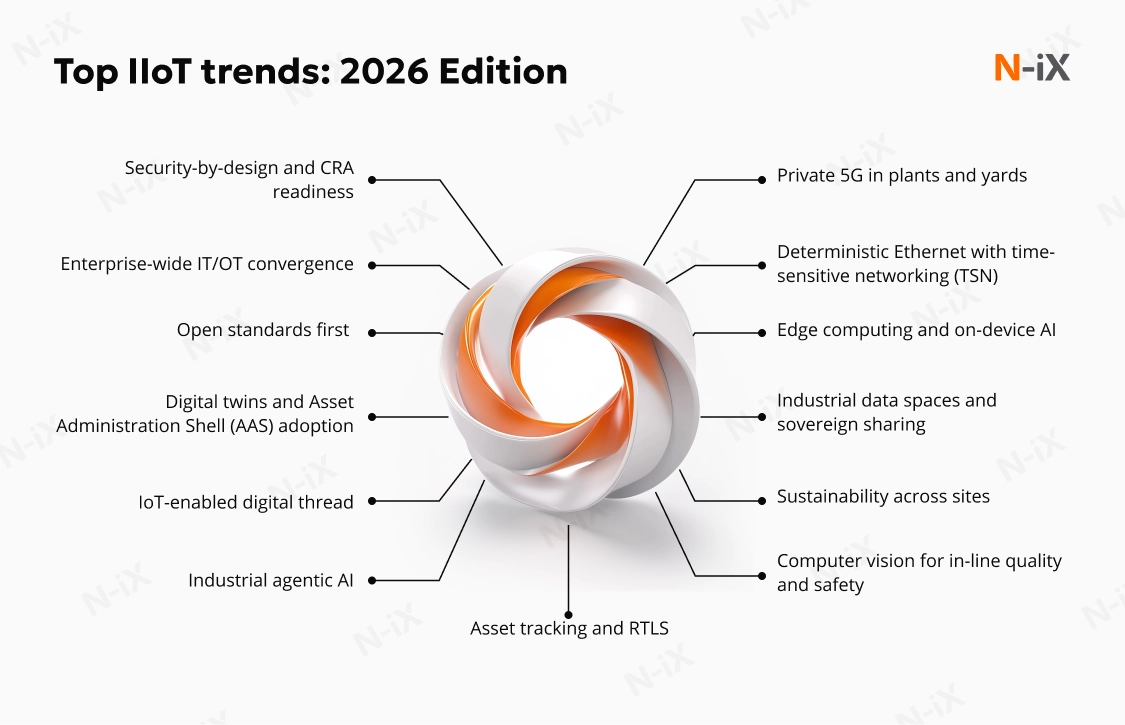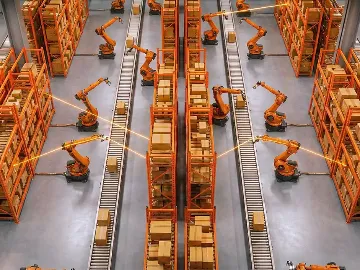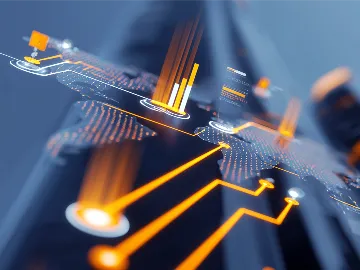The industrial Internet of Things (IIoT) market is rapidly transforming, with smart manufacturing technologies driving major shifts across industries. According to Statista, IIoT accounted for 24.3% of global IoT market revenue in 2023, highlighting its expanding impact on industrial competitiveness [1]. Meanwhile, industrial businesses continue to lead IoT development, with investments in IoT surpassing those of other sectors [2]. As adoption accelerates, many IIoT trends reshape how manufacturers operate, innovate, and grow. Let's explore the state of industrial IoT today-and the IoT trends in manufacturing your business should prioritize to remain competitive.
At a glance: Current state of IIoT
Adopting IIoT trends in manufacturing requires a proper strategy and investment. Since reliability is a critical aspect of manufacturing, new technologies are adopted gradually. Companies need time to ensure these innovations add value rather than hinder performance. However, those who've already implemented IIoT technologies have already reported the positive effect it has on their business.
- According to the Hive MQ's report on building industrial IoT systems in 2024, 29% and 23% of IoT adopters reported increased productivity and improved overall equipment effectiveness (OEE) as main gains [3].
- As much as 68% of Eseye's survey respondents stated that their main benefit of IoT adoption was increased revenue [5].
- Over 30% of manufacturing businesses report being ready to double the number of IoT devices on their sites [5].
- As the 2024 IoT & Embedded Developer Survey Report states, industry leaders emphasize the need for IEC 61508 and ISO 26262 certifications, particularly when developing solutions for the automotive, medical, and industrial sectors [4].
With more successful case studies being reported, the industry is learning to navigate the challenges and obtain high ROI. If you're exploring what's going on with IIoT now and how it may progress in the future to keep up with the competition, keep on reading.
Explore the topic: Industrial IoT use cases: 15 examples that change business
Major trends in industrial IoT for 2026 and forward

1. Security-by-design and CRA readiness
According to the IIoT World survey, 35% of businesses reported cybersecurity as a major challenge for implementing a new IIoT system [3]. And this survey is not the only one showing constant concern for IIoT ecosystem security. With cyberthreats like device hijacking, data siphoning, data breaches, device spoofing, and others, businesses are focusing on strengthening their cyber resilience. However, reliability and security aren't solely business needs-they're becoming a legal requirement.
The EU has adopted the Cyber Resilience Act (CRA) to ensure security-by-design principles for manufacturers of products with digital elements [6]. Every business entity subject to these regulations must improve device security, manage software bill of materials (SBOM), and monitor/report vulnerabilities throughout the lifecycle.
Reasons to consider this trend: Fewer unplanned outages, faster incident response, compliance readiness, safer products, improved brand image.
2. Enterprise-wide IT/OT convergence
Traditionally, information technology (IT) and operational technology (OT) operated in silos. IT focused on data management and business applications, while OT dealt with machinery, sensors, and production processes. However, as enterprises embrace Industry 4.0 and Industry 5.0, the need for IT/OT convergence has become increasingly apparent. Industrial IoT plays a crucial role in making this process possible.
IT/OT convergence is essential to optimizing operations, enabling comprehensive data visibility, improving efficiency, and driving innovation. By adopting IIoT, businesses can standardize on modern networking, virtualization, hybrid cloud-edge computing, and AI-assisted operations, bridging the gap between MES/SCADA systems and enterprise IT.
Reasons to consider this trend: Shorter changeover times, faster access to data for quality assurance and maintenance, and safer, quicker rollouts of applications across sites and production lines.
More on topic: IoT in smart manufacturing: Insights for enterprises
3. Open standards first
Since manufacturers are moving towards Industry 4.0 and Industry 5.0, the need for data interoperability is increasing. However, it's difficult to achieve in the industrial setting with plenty of connected systems that lack communication between each other. Groups of devices from various vendors often make data sharing impossible without additional configuration. It results in only fractional use of the IIoT potential, preventing the enterprise from reaching the benefits this tech may offer.
Manufacturers can overcome these barriers with open standards, such as OPC UA, MQTT Sparkplug, and others. Open standards enable universal connectivity and integration across devices and systems. They are essential for reducing integration costs, speeding up deployment, and improving data quality. By adopting these standards, businesses can scale automation, implement predictive maintenance, and enhance product lifecycle management across multiple sites.
Reasons to consider this trend: Lower integration costs, faster deployment, improved data quality, scalable automation, more efficient factory operations.
Looking for a reliable tech partner for the IIoT project? Read an expert's guide to outsourcing IoT development for growth
4. Digital twins and Asset Administration Shell (AAS) adoption
Connected sensors and IoT devices help manufacturers create virtual representations of physical assets, processes, or entire production lines. These digital twins allow for real-time monitoring, simulation, and process optimization across the entire product lifecycle-from design to decommissioning. As IIoT adoption scales, digital twins help unify and process the vast amounts of data generated by connected devices, turning fragmented data streams into actionable insights that drive smarter decisions.
Asset Administration Shell (AAS) is one of the enablers of making these digital twins interoperable. AAS serves as a standardized digital model defined within the Industry 4.0 framework, ensuring that each asset-whether a machine, component, or software module-can communicate data consistently and securely across IIoT ecosystems. By adopting AAS-based digital twins, manufacturers can achieve interoperability between diverse systems, streamline engineering processes, and improve product traceability within the broader IIoT network.
Reasons to consider this trend: Portable asset data across vendors and tools, faster commissioning, simpler multi-site scaling of analytics, responsive monitoring of asset performance, more efficient factory operations.
5. IoT-enabled digital thread
A digital thread is a digital representation of a product's lifecycle. Its primary goal is to make every interaction across the value chain traceable and accessible, creating a single, centralized source of the truth across departments and systems. As IIoT adoption accelerates, the IoT-enabled digital thread is emerging as one of the top industrial IoT trends in manufacturing.
IIoT sensors provide continuous data from assets and processes, ensuring accurate, up-to-date information flows seamlessly across all stages of production. By leveraging IIoT sensors, product lifecycle management (PLM), computer-aided design (CAD), and enterprise resource planning (ERP) systems, digital threads enable real-time data integration. This allows manufacturers to connect workflows and departments seamlessly.
Reasons to consider this trend: Portable asset data across departments and systems, faster time to market, improved product traceability, enhanced cross-functional collaboration, more efficient production cycles, improved compliance.
6. Industrial agentic AI
The rise of AIoT applications has influenced further adoption of AI in industrial settings. Agentic AI refers to AI systems that can make decisions, manage tasks, and take actions independently based on real-time data. These systems go beyond traditional automation by analyzing and interpreting data from IIoT devices and sensors. Based on the results, they can autonomously adjust processes or equipment settings without human intervention.
Agentic AI is becoming one of the industrial IoT trends, as manufacturing operations move from reactive to autonomous systems. It's particularly relevant for businesses considering IIoT adoption or seeking to optimize their IIoT systems further. By leveraging agentic AI, manufacturers can unlock new levels of efficiency, reduce downtime, and increase responsiveness to production issues. For example, Siemens's industrial AI agents can analyze sensor data from machines to predict failure points and automatically adjust operations.
Reasons to consider this trend: Reduced downtime, enhanced operational efficiency, faster response and resolution times, lower operational costs, scalable automation.
7. Asset tracking and real-time locating systems (RTLS)
Monitoring the location and status of tools, materials, and vehicles within facilities and across supply chains plays a critical role in industrial settings. Knowing the precise location and status of equipment, inventory, and tools helps businesses minimize delays, prevent asset misplacement, and ensure more efficient operations.
IIoT enables asset tracking and real-time locating systems (RTLS) by integrating RFID, UWB, Bluetooth AoA and AoD, and other sensors into manufacturing environments. This connection of assets through IIoT allows for seamless tracking across systems like MES and ERP, automating processes and ensuring that the right assets are in the right place at the right time.
Reasons to consider this trend: Enhanced real-time asset visibility, minimized downtime, streamlined inventory management across the value chain, improved operational efficiency, automated and scalable tracking across sites.
Related: IoT in the automotive industry: Driving innovation
8. Private 5G in plants and yards
The number of IIoT devices is constantly growing, causing the need for faster and more secure connectivity and data transmission options. Private 5G, being a high-speed, low-latency connectivity, is becoming one of the major trends in industrial IoT connectivity.
Private 5G networks provide greater control, security and customization, making them ideal for business-critical industrial applications. This technology allows for real-time data transmission that's used for real time asset tracking, video QA, and facility surveillance, etc. According to Ericsson, businesses already use this technology for real-time predictive maintenance, inventory optimization, and connected worker solutions.
Reasons to consider this trend: Enhanced connectivity for real-time data exchange, improved security and control over network infrastructure, reduced communication downtime, optimized operational efficiency, and quicker decision-making.
9. Deterministic Ethernet with time-sensitive networking (TSN)
In industrial IoT, real-time data processing and communication between connected devices are crucial for ensuring operational efficiency and safety. It's even more so in time-critical solutions often used in robotics, automation, or real-time control systems. To enable it, businesses are switching from traditional to deterministic Ethernet.
Contrary to traditional Ethernet, whose performance is based on network congestion, deterministic Ethernet with time-sensitive networking (TSN) ensures that data is delivered within a strict time frame, which is vital for IIoT systems that rely on real-time decision-making and synchronization. In addition, TSN plays an important role in IT and OT networks integration, ensuring that both industrial control systems and business operations can function seamlessly on a unified network.
Reasons to consider this trend: Predictable and low-latency data transmission, improved synchronization across connected devices and systems, efficient bandwidth management, IT/OT convergence, enhanced reliability and performance.
10. Edge computing and on-device AI
As the number of devices sending data to the cloud increases, so do the cloud costs. To reduce these costs, businesses adopt edge computing and on-device AI. These technologies enable faster data processing, real-time decision-making directly at the source, safer data transmission, and enhanced privacy.
As Eseye IoT adoption report states, over 87% of surveyed manufacturers agreed that the devices should become more intelligent and process data on the edge [5]. Instead of sending all data to the cloud, edge devices (gateways, sensors, or controllers) will analyze information locally. In industrial environments, where machines generate massive volumes of time-sensitive data, this local processing is critical. This reduces latency, improves reliability, and allows systems to keep running even when connectivity is limited.
Reasons to consider this trend: Faster incident response times, improved reliability, reduced bandwidth and cloud costs, enhanced real-time analytics, and greater resilience of industrial operations.
Discover related trends: Embedded software trends 2026: Embracing the changes
11. Industrial data spaces & sovereign sharing
With the increasing complexity of supply chains and industrial networks, manufacturers are facing the challenge of managing vast amounts of data generated by IIoT sensors, devices, and systems. As industries become more interconnected, securely sharing this data across ecosystems is crucial. However, companies are also concerned about data privacy, security, and ownership as they collaborate with partners, suppliers, and customers.
Frameworks like Catena-X and Gaia-X enable secure and sovereign data sharing. They allow businesses to share critical IIoT data, such as real-time machine performance or predictive maintenance insights. At the same time, they can still maintain ownership and control over their proprietary information.
Reasons to consider this trend: Secure, collaborative data sharing across ecosystems, enhanced compliance with data privacy regulations, real-time insights, optimized supply chain management, new business opportunities through data exchange.
Read more: IoT predictive maintenance: What every executive should know
12. Sustainability across sites
Manufacturing businesses are increasingly expected to lower energy consumption, reduce waste, and implement sustainable practices across all their operations. Environmental regulations, resource scarcity, and consumer demand for sustainable products are the major reasons why sustainability is among the steady IIoT trends. Moreover, the participants of the 2024 IoT & Embedded Developer Survey Report mentioned increased activity in energy management (29%), environmental applications (23%), healthcare (18%), and home automation (25%) [4]. It signals a rising focus on adopting IoT in sustainability and lifestyle solutions.
IIoT devices and systems help businesses gather and analyze real-time data on energy usage, resource consumption, and emissions. With operations spread across multiple locations, businesses need a centralized, data-driven approach to effectively measure and manage their sustainability efforts.
Reasons to consider this trend: Reduced energy consumption and operational costs, improved environmental compliance and reporting, increased sustainability across multiple sites, optimized resource utilization, waste reduction, stronger brand image.
13. Computer vision for in-line quality and safety
Manufacturers seek smarter, faster, and more reliable ways to monitor production lines. Computer vision (CV) systems powered by AI and IIoT sensors can inspect, detect, and analyze product quality in real time, ensuring higher accuracy and greater efficiency. The growing need for automated quality assurance and worker safety in high-speed, high-volume production environments fuels the adoption of these technologies.
A case in point, our IoT developers helped a client, an industrial fleet tracking company, to integrate a solution that helped detect objects and workers around to avoid collision. As a result, the company enhanced on-site safety.
Reasons to consider this trend: Improved product quality and consistency, reduced inspection times, enhanced worker safety and compliance monitoring, reduced human error and reliance on manual processes, scalable real-time monitoring across multiple production lines or sites.
To benefit from IIoT trends in 2026, you should partner with a tech team with domain knowledge, tech skills, resources, and reliable partnerships with tech providers. Here are a few reasons to consider N-iX for the job.
N-iX is your reliable tech partner for adopting effective IIoT trends
At N-iX, we specialize in delivering custom IoT solutions that empower industrial manufacturers to embrace the latest IIoT trends. With over 2,400 experts, we have the deep technical expertise to help you optimize operations and enhance safety across your industrial environment.
Our technical capabilities cover the entire industrial IoT stack, including IoT consulting, firmware development and embedded software development. We help you engineer connected devices and develop wearable apps to bring your business into the Industry 4.0 era. With our IoT security services, you can ensure regulatory compliance and adopt the necessary cybersecurity measures to prevent incidents.
N-iX has established partnerships with various tech providers that can support your industrial operations on various levels. For example, we partner with Nordic Semiconductor, Arduino, and Raspberry PI to help you ensure IIoT hardware reliability. We also work with AWS, Microsoft Azure, and GCP cloud providers, helping you with sensor data analytics for industrial applications. In addition, we are MathWorks partners and collaborate with them on digital twins and robotics projects involving modeling and simulation.
Our domain experience includes solutions built for clients in finance, manufacturing, logistics and supply chain, retail, telecom, automotive, healthcare, energy and utilities, and agritech. We've completed over 60 IoT and embedded projects, helping our clients navigate the connected future.
With us by your side, we can help you solve operational inefficiencies, ensure predictive maintenance, deal with quality and safety challenges, streamline asset tracking, and more. Let N-iX guide you through the complexities of IIoT adoption, helping you stay ahead in the competitive industrial landscape with investment-worthy technologies.
Sources:
- Industrial IoT: market data & analysis 2024 | Statista
- Global Machinery & Equipment Report 2024 | Bain & Company
- Building Industrial IoT Systems in 2024 | Hive MQ
- 2024 IoT & Embedded Developer Survey Report | Eclipse Foundation
- 2024 State of IoT Adoption Report | Eseye
- Cyber Resilience Act - 2024/2847 - EN | EUR-Lex
FAQ
1. What is the difference between IoT and industrial IoT?
The Internet of Things (IoT) connects everyday devices, like home appliances or wearables to collect and share data. In contrast, the Industrial Internet of Things (IIoT) focuses on connecting machines, sensors, and systems in industrial environments such as factories or power plants.
2. What is the architecture of industrial IoT?
The IIoT architecture typically includes four layers: sensor, network, cloud, and application. Sensors and devices collect data, which is transmitted through secure networks to edge or cloud platforms for analysis. The processed data are then used by industrial applications to enable automation and predictive maintenance.
3. What is the future of IIoT?
The future of IIoT lies in greater automation, intelligence, and connectivity across industrial systems. Advancements in AI, edge computing, 5G, and digital twins will enable real-time decision-making, predictive maintenance, and more sustainable operations. As industries evolve toward Industry 5.0, IIoT will drive collaboration between humans and machines for smarter, safer, and greener manufacturing.
Have a question?
Speak to an expert





